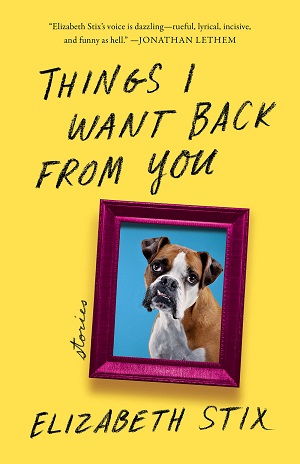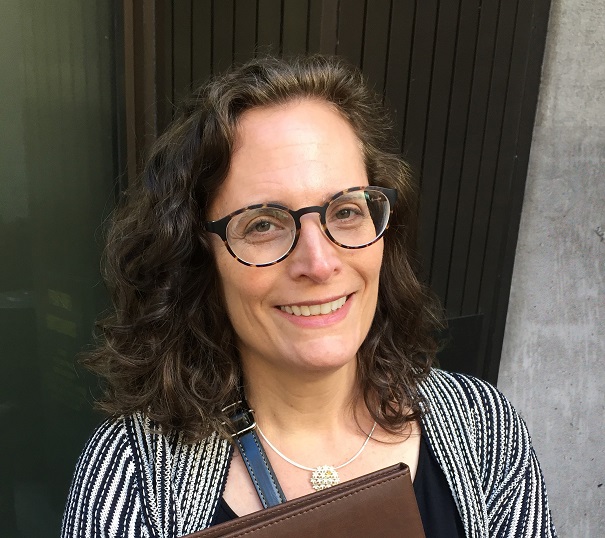You can go there. The further you push the story, the more true it becomes.
Elizabeth Stix – 14 June 2024
The Back Flap
Set in the fictional California town of San Encanto – a place where suburban angst coexists with the astonishing – a lonely wife finds her oppressive husband has become a dirigible who follows her from the sky, a neglected boy spends his summer unwinding a parasitic Guinea worm from his little sister’s belly, and an aspiring life coach attends a self-actualization seminar that goes wildly off the rails. In Things I Want Back From You, Elizabeth Stix’s hilarious and poignant debut of 21 linked stories, hopelessly flawed characters flail against their own insecurities, seeking one true moment of connection, and if they’re lucky, winning that rarest of gifts – a second chance.
About the book
What is the book about?
Things I Want Back From You is a linked short story collection with a quirky, comic sensibility. The book follows a cast of characters who live at the end of a cul de sac in a fictional California suburb called San Encanto. Most dominantly, Things I Want Back From You,follows the Zinger family: Abby, a depressed teenager who navigates her way to middle age; her brother Ollie, a magician whose manipulations are great on stage but not so successful at home; their overprotective mother Betty; and their father Robert, a budget travel writer who struggles to remain relevant. They weave into each other’s lives and stories, and those of their neighbors, co-workers and colleagues, over the course of about 50 years.
When did you start writing the book?
The book had a really long gestation period. The first story was published in 2004. The last one was published in February 2024.
How long did it take you to write it?
It took me a very long time!
Where did you get the idea from?
Each story has its own germination. Sometimes I start with a relationship or a character, or a feeling. Sometimes I start with a voice. Sometimes I start with a writing prompt. Sometimes I’ll brainstorm ideas into my phone while I’m taking a walk.
Were there any parts of the book where you struggled?
The hardest part was probably seeing the shape of it, and deciding how all the stories could form a larger whole. The collection wasn’t linked at first, and over time it became quite deeply linked. It wasn’t until I thought really hard about setting, and placed them all in a fictional town that could contain both the real and surreal elements, that it finally came together.
What came easily?
Sometimes stories came out quickly, if I heard a character’s voice very clearly right off the bat. I wrote the first draft of the title story in about an hour, and didn’t change it very much after that. Some of the shorter pieces came easily as well. The further along I got, the easier it became because I knew more about where I wanted to go.
Are your characters entirely fictitious or have you borrowed from real world people you know?
All the characters are fictitious. If anything, they reflect different parts of myself, since they all came from my imagination.
We all know how important it is for writers to read. Are there any particular authors that have influenced how you write and, if so, how have they influenced you?
The first short story collection that had a real impact on me was Reasons to Live by Amy Hempel. I was so struck by her voice and her choices – what she said and what she chose to hold back. Her sense of timing is so precise. A.M. Homes was an early influence too – just showing me that yes, you can say that. You can go there. The further you push the story, the more true it becomes. Lorrie Moore was a big influence in her use of humor. George Saunders’ Tenth of December is basically a perfect short story collection. The Imperfectionists by Tom Bachman is a great example of how to link stories in a really intricate, interesting way. There’s a story by Adam Haslett called “Notes to My Biographer” in his collection You Are Not a Stranger Here that was really eye-opening in terms of what you can do with voice. He found a voice that just propels that story forward like a freight train. If you can hear a voice like that, that’s the best. There are so many great short story writers. I love Bobbie Ann Mason. Margaret Atwood. I could go on.
Do you have a target reader?
I try not to think about it. I do better when I don’t think about the outcome, if I concentrate on my relationship with the story, and then let it go.
About Writing
Do you have a writing process? If so can you please describe it?
I have a home office that I write in. I’ve worked in writing collectives and offices, but I really need quiet and isolation. Sometimes I put on soft padded headphones to block out noise even if it’s already quiet. Just the soothing absence of sound helps me concentrate and relax.
Do you outline? If so, do you do so extensively or just chapter headings and a couple of sentences?
I outline a little more now than I used to. But with a short story, it’s less important than it is with a longer work.
Do you edit as you go or wait until you’ve finished?
I try to wait until I’m finished. Otherwise you can tweak a sentence to death and just end up procrastinating.
Did you hire a professional editor?
Lucky for me, several of my friends are professional editors, as am I. We trade work and their feedback is incredibly helpful.
Do you listen to music while you write? If yes, what gets the fingers tapping?
Never.
About Publishing
Did you submit your work to Agents?
I did. I have an agent named Henry Dunow.
What made you decide to go Indie, whether self-publishing or with an indie publisher?
Henry sent the manuscript out to a bunch of the big houses, and though we got a lot of very kind rejections, nobody took it.
Was it a particular event or a gradual process?
The funny thing was, the day after I signed the contract with Henry, Diane Goettel from Black Lawrence Press called me and said she wanted to publish the book. I had sent it to her several months before. I was so happy, but I told her that I wanted to give it a shot with the agent first, and she agreed. When it didn’t pan out, I reached out to her again about a year later and asked her if she was still interested, and to my good fortune, she was.
Did you get your book cover professionally done or did you do it yourself?
Black Lawrence Press uses a terrific designer named Zoe Norvell. I love the cover she made for the book.
Do you have a marketing plan for the book or are you just winging it?
I’m actually enjoying the marketing part much more than I thought I would. I’m more of an introvert, so I thought it would be hard for me. But I’m also organized and it has been really satisfying to track down opportunities and give it a shot. Who knew? I also did hire a publicist, who is great. I’m in a group with several other women who have books coming out this year. We meet every two weeks and chat online, give each other feedback and advice and help promote each other’s books. I highly recommend doing something like that. It’s much more fun if you’re not doing it alone.
Any advice that you would like to give to other newbies considering becoming Indie authors?
There are a lot of independent presses out there. Make sure your manuscript is as clean and great as you can make it, and then send it out there. Don’t give up. Don’t take any turn-down personally. You’ll find the right home for your book.
End of Interview:
For more from Elizabeth Stix visit her website and follow her on Instagram, and Twitter.
Get your copy of Things I Want Back From You from Amazon.


